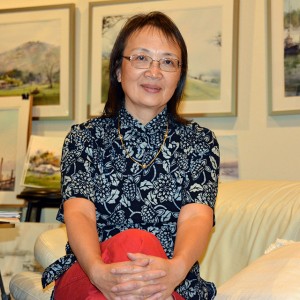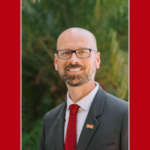
Shuang Li
As a child growing up in the People’s Republic of China, Shuang Li loved to doodle. And today she’s a full-time professional watercolor artist who teaches her craft at the Osher Lifelong Learning Institute at San Diego State University. What happened in between is a journey so circuitous, that life as an artist would seem like an impossible outcome.
Li’s childhood doodling came to an abrupt halt when her family was sentenced to harsh labor in a remote countryside. It was the 1970s, a politically turbulent time in China.
“During those years, I was in a survival mode with my parents,” said Li. “Art was too much of an unaffordable luxury to even think about.”
By the time she approached high school age, the political climate had changed and the family was able to return to the city.
“That’s when I had my very first, brief basic fine-art training from a relative who was a professional artist,” said Li. “I was hooked instantly and began to seriously consider becoming a professional artist.”
You were among 65 finalists admitted to a highly regarded fine art college in Northern China in 1978.
Yes, after very rigorous exams with 2000 talented youngsters, I was admitted. Instead of pursuing my fine art dream, I majored in graphic design — a field that my parents thought was both politically safe and financially viable at that time in China.
Tell me more about the rigorous exams.
Day one was a drawing test; day two was painting still life; then, because I was in graphic design, on day three I had to design a commercial package. Day four was literature testing, and day five was political knowledge. You must have that. If you don’t have that in China, forget about any other scores. Then there was an interview with five professors. I don’t know how I passed it.
What was your education there like?
I experimented with various art media, such as gouache, acrylic, oil. Watercolor courses were not offered, however. My professors implied that watercolor was just for kids or amateurs, and it should not be a professional’s choice, at least at that time in China. Upon graduation, I started my academic career as a lecturer working for Central Academy of Arts & Design in Beijing. Concurrently, I was studying for my first master’s degree in History of Chinese Art and Craft. I was so busy that I simply had to stop doing any painting or drawing. My brushes were under the bed, covered with dust.
When did you come to the United States?
In 1988 I decided to pursue another master’s degree in the U.S. at the University of Oregon’s School of Architecture and Allied Arts. This time, a computer mouse replaced all my brushes. I was majored in the pioneering field of computer graphics and fell in love with the amazing marriage of art and technology. Soon after receiving my MFA from the university in 1991, I went straight to work for Microsoft. From that point on, I fully submerged myself into the computer industry for over 20 some years.
Did you have time for fine art?
At the end of the 90s, with the burst of the dot-com bubble, I started going back to my old dusty brushes — working with them seemed to have the therapeutic effect of reducing work-related stress. I joined Pacific Art League, a Silicon Valley art organization, and also attended a watercolor class for the first time in my life. I started trying out this medium and thought I could become proficient quickly, based on my past training. To my surprise, watercolor seemed to elude me. It was so hard to control, and all my paintings turned out awful — dark, muddy, boring and had no sign of life. Every piece was a complete failure, and I didn’t understand why.
What turned your watercolor experience around?
One day I ran into a book titled Learn Watercolor the Edgar Whitney Way. When I flipped through the book, it was like lightning had hit me — I saw great watercolors by Edgar Whitney and his followers such as Tony Couch, Skip Lawrence, Frank Webb, Cheng Khee Chee . . . a big group of them! I also read through Whitney’s Elements of Design and Principles of Design, and I was shocked, completely shocked. Why didn’t I know how to use these principles in my watercolor?
How can Edgar Whitney’s design principles best be summarized, and do you use them in your classes?
Yes I do. His principles have many points, but they are basic and everybody can learn them. For example, the first point is that you need a center of focus in your painting. Second point, you need to understand values, not colors. Value is not about money, it means tone – how light or dark a color is. Every color can produce a variety of tones, and you should be painting with a clear value pattern in mind.
What’s the number-one tip you give students in terms of controlling this difficult medium?
There are two tips I usually give: You need to use water without fear and know how to control it. And timing is part of it. You need to know how much water is in your brush, the proportion of paint that is mixed in, and at what time you apply this brushstroke — when the paper is either wet, damp or dry. Every single second counts.
For my second tip, I’ll tell you a story. At the end of a four-day workshop, a student came to me and said, “I tried everything you said, every step you described in the past four days and I still can’t paint as you do.” I said, “There’s one secret I haven’t told you. I failed 999 times. How many times have you failed?”
When did you first start teaching at the Osher Institute and how did that come about?
It’s a very recent experience. I had my first Edventure on March 22, 2014 (Watercolor Sketching En Plein Air at Historic Old Town). And in April I gave a lecture on Art in China Today.
At a friend’s party, I met SDSU English/Children’s Literature professor (and Osher instructor) Alida Allison. She was ready to retire from her role as a full-time professor and I told her I quit my job to pursue painting. She said, “You should teach at our extension program.” I gave a lecture in the past at the Mingei Museum on Chinese art, so my Osher proposal was for that. But when the program director (Emily Moore) saw on my resume that I was also a watercolor artist … she wanted me to teach. So both things happened at the same time – the lecture and the watercolor class.
When did you quit your job to pursue painting full time?
In January of 2007, I was diagnosed with breast cancer and underwent a long, 10-month treatment. As I battled cancer, I kept asking myself one question over and over again: what’s important in my life? I knew from the bottom of my heart that I still had one major goal to achieve in my life — to be a full-time artist painting with watercolor! At the beginning of 2011, with the full support of my loving husband and many close friends … I finally ended my corporate career and started to fulfill my childhood dream.
Are many of your Osher Institute students like you, retired from corporate careers and now finally addressing their dreams?
All my students are in that category. Retired, had art dreams in the past, and now they have the time and want to realize their dreams. (Editor’s note: Outside of Osher, Li also teaches for the San Diego Watercolor Society, and private classes both domestically and overseas.)
You taught Watercolor Sketching En Plein Air for the Osher Institute, and I’ve read that you love painting outdoors because it sharpens your skills and techniques. How so?
It’s because I’m a representational painter, versus abstract. I’m transferring a real-world three-dimensional image onto two-dimensional paper. If you work from a photo, it’s already flattened. It doesn’t teach you the real thing. Nature teaches you everything.
Can students expect to complete an entire painting in your three-hour En Plein Air class?
Yes. I usually finish my plein airs in 45 minutes.
Have you seen students who’ve never painted before become passionate about watercolor?
Oh yes, many. It’s a very difficult medium but because it’s very challenging, you get addicted to it in a way. It’s so spontaneous that you don’t have to have full control; you just have to let the watercolor paint by itself. Then it all turns out like magic. Many people want everything in control in their life and art. They can still do that, but I choose to control only a portion of my art and the rest is up to the watercolor itself.
How has teaching Osher students inspired you personally?
No matter what your starting level is, I like to teach people who are serious about learning, not serious about their end results. That’s the key and I get inspired by people’s persistence and their desire to learn. Some of my students are in their 90s and they paint every day.
What words of encouragement would you give to those who have yet to pursue their creative dreams or even just take a class at the Osher Institute?
People think you have to have talent to do art. I think talent belongs to only a few like Van Gogh or Da Vinci. Most of us are ordinary people but we can still do art. Your art doesn’t need to hang in the Louvre. You use your sixth sense to draw and paint. Everybody has it. You just need to bring it out.




